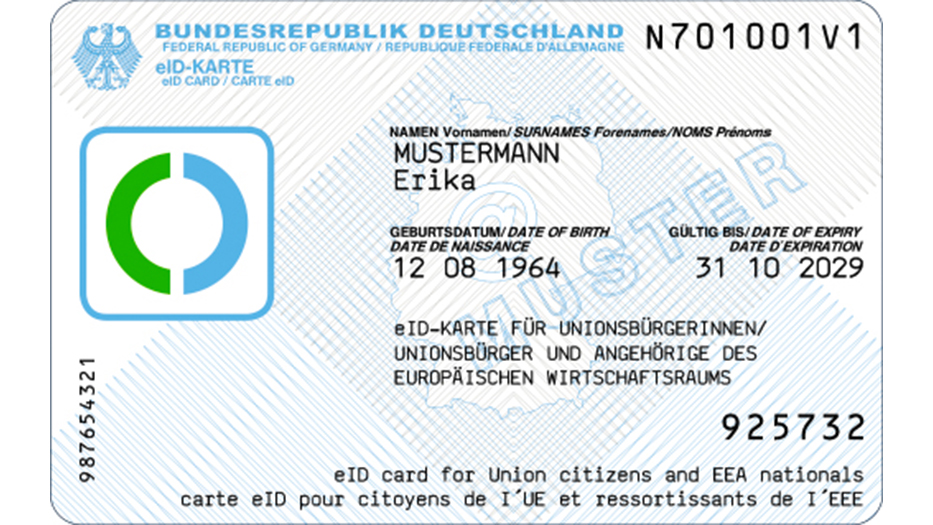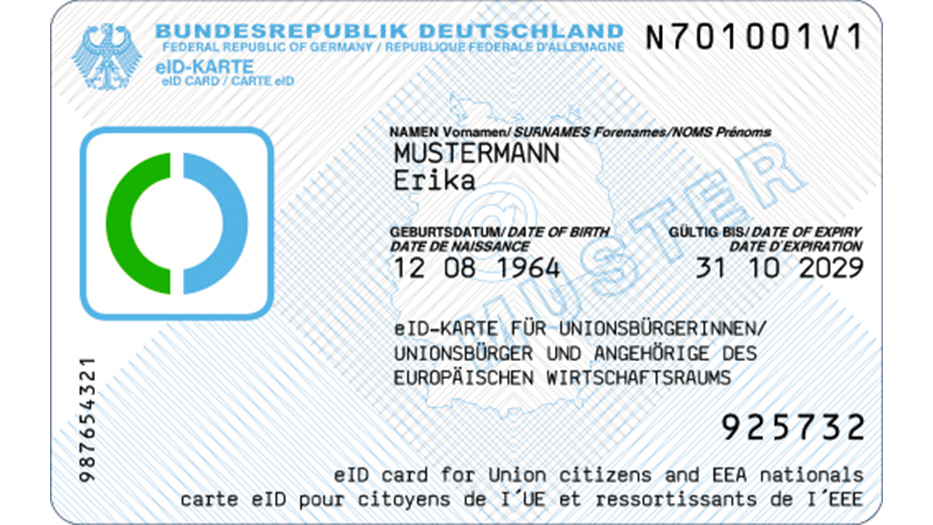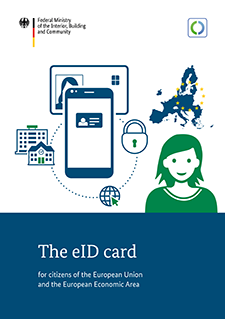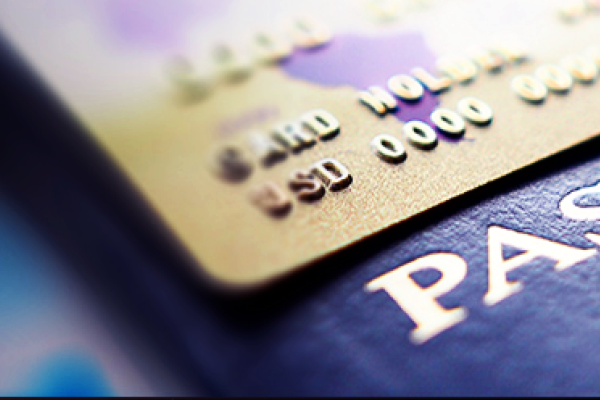What are you looking for?
Eid: the card with an electronic identification function for citizens of the european union and european economic area nationals.
The new eID cardsample eID card, © Federal Ministry of the Interior, Building and Community
On 1 November 2019, the Act on a Card with an Electronic Identification Function for Citizens of the European Union and the European Economic Area (eID-Karte-Gesetz, or eIDKG) entered into force. As of 1 November 2021, eID cards can also be issued by Germany’s missions abroad.

The new eID card: general information
Who can apply for an eid card, documents you will need to apply, validity and fees, useful links and information:.
With the eID card , citizens of the EU and European Economic Area nationals can deal with official or business matters by using the online function of their identity card or their electronic residence permit.
Please note that the eID card with an electronic identification function is designed specifically for the provision of digital services. The card is not intended to replace an approved and valid passport or identity card, especially when travelling. The eID may therefore under no circumstances be used as an official travel document.
● Citizens of the European Union and
● of the other countries in the European Economic Area (Iceland, Liechtenstein, Norway)
● not German citizens
● at least 16 years old.
To apply for your eID card, you will need to completely fill out and present an application form along with a valid identity document issued by your home country, e.g. a passport or a national identity card.
Your address will be stored on the chip of the eID card. You will therefore need to present proof that you are habitually resident abroad, e.g. a residence permit, a residence registration certificate or a lease. If necessary, you may be requested to present additional documents.
Requests for the issuing of an eID card must be submitted in person at the German Embassy. For this, you must make an appointment through the online booking System. For further information and details on necessary appointments please refer to the website of the German mission in your Country of residence .
The eID card is valid for 10 years and the issuing fee is 37 euro.
The validity of eID cards cannot be extended. You can however apply for a new eID card before your previous card expires. To do so, you must demonstrate that you have a justified interest in a new Card.
- Act on a Card with an Electronic Identification Function for Citizens of the European Union and the European Economic Area (eID-Karte-Gesetz, or eIDKG)
- Information on the eID card is available on the website of the Federal Ministry of the Interior, Building and Community
- Further information on the eID card is available on the portal of the Federal Ministry of the Interior, Building and Community
- Brochure of the Federal Ministry of the Interior, Building and Community
- Top of page
Navigation and service
A notice about cookies.
Some cookies are technically necessary for the website to function. In addition to these necessary cookies, you can choose here whether to allow us to collect statistical information in fully anonymised form and without the use of cookies. This information helps us to understand how visitors use our website. You will find more information about data protection in our Privacy Policy

German ID Card
The electronic residence title
eID Card for citizens of the EU and the EEA
Electronic Identification
On-site reading
Security and data protection
- Offering electronic identification
- For Service Providers
- For Identification Service Providers
- Approval procedure for user accounts
- eIDAS-compliant remote signature with eID
- The Digital Identities project
- eIDAS Regulation
Applications for the eID function
- Questions and Answers
You are here:
type: Article
The new eID card for citizens of the European Union (EU) and the European Economic Area (EEA) was introduced on 1 January 2021.

Source: Federal Ministry of the Interior, Building and Community
Its legal basis is the “ Act on a Card with an Electronic Identification Function for Citizens of the European Union and the European Economic Area ” (eID-Karte-Gesetz – eIDKG), which came into force on 1 November 2019.
With the new eID card you can identify yourself on the internet, at vending machines (i. e. to confirm your age) and the self-service terminals in public authorities - in an easy, quick and secure way.
To do this, you use the electronic identification (eID) function of the eID card. Technical basis for the eID function is the same as it is in the German ID card.
The new eID card – some facts
Citizens of the European Union and the European Economic Area that are not Germans can apply for an eID card.
Please note that the eID card for citizens of the EU and the EEA with eID function is intended only for use of digital services. It does not replace the recognized and valid foreign passport or identity card for identification, e. g. when travelling. The eID card therefore can never be used as an official travel document.
The eID card is issued to you for a period of ten years and for a fee of € 37.00.
Applicants must be at least 16 years old.
The validity of your eID card cannot be extended.
Before your eID card expires, you may apply for a new one if you can demonstrate a legitimate interest in having a new one issued.
In Germany, you can apply for an eID card at the identity card authority of your local municipal office.
If you are not resident in Germany, you can apply for an eID card outside Germany since 1 November 2021 at the German missions abroad designated by the Federal Foreign Office.
Necessary documents
To apply for your eID card, you need the valid identity document issued by your home country, e.g. a passport or a national identity card.
Your address is also stored in the chip of the eID card. If you live and are registered in Germany, the responsible eID authority (Bürgeramt) knows your address. If you have just moved to Germany, you must register with a German registration office. You can find out which documents are required for registration from your registration office.
If you do not have a residence in Germany, you will need to provide other proof of your residence. You can enquire at the relevant German mission abroad (embassy or consulate) about which documents are required.
This information is visible on the eID card
Front of the eid card.
On the front of the eID card the following data are visible.
on the left
- logo of the eID function
on the right
- serial number
- surname and forename(s)
- date of birth
- date of expiry
- card access number (CAN)

Here you can use your eID card
Public or private service providers that wish to make registration procedures easier and more secure for you offer the eID function.
With your eID card, you can use digital administration services on the administrative portals of the federal and state governments and set up your own user account for the electronic proof of identity.
Some companies, such as mobile telecommunications providers and financial service providers, also offer you the use of the eID function.
Example of the digital services with eID identification that are offered in Germany by authorities and businesses are listed here .
Much more applications you will find on the German site of the Personalausweisportal .
More and more authorities of EU member states also offer digital services that may be used with the German eID function. This option will be indicated on their websites.
On-site reading with the eID card
Another function of your new eID card is the so called on-site reading. Please note that for using the on-site reading at first you have to identify yourself at the point of sale by using your valid passport or official photo ID. This is different from using the German ID card for on-site-reading.
More information on on-site reading you find here.
Broschure: The eID card for citizens of the European Union and the European Economic Area type: Download , Date: 15 December 2020
In December 2020, the Federal Ministry of the Interior, Building and Community published a new brochure providing information about the eID card for citizens of the European Union and the European Economic Area. On 16 pages, you will find the most important information about your eID card with eID function briefly and clearly explained.
PDF, 442KB, accessible file

Related topics
Back to Citizens
- Recommend page
Visit us on
- Contact form
- Lost your ID card?
- Federal Ministry of the Interior
Public enquiry service
For general questions to the Federal Ministry of the Interior and Community, please contact our public enquiry service. Mondays to Thursdays: from 8 a.m. to 5 p.m. Fridays: from 8 a.m. to 3 p.m.
+49 228 99 68 10 + 49 30 18 681 0
Welcome to the official ETIAS website
- ETIAS is currently not in operation and no applications are collected at this point.

The rules of travel to Europe have changed. Starting in the first half of 2025, some 1.4 billion people from over 60 visa-exempt countries are required to have a travel authorisation to enter most European countries.

Find out which European countries require an ETIAS travel authorisation, who needs to apply and who is exempt.

Learn about when to request an ETIAS travel authorisation with limited validity and what implications it has for your travel.

Find out what travel documents can be used to apply for an ETIAS travel authorisation. Learn about what information needs to be included in the application form and how much it costs to apply.

Learn how to authorise someone to apply for an ETIAS travel authorisation on your behalf and what to be careful about.

Find out how to appeal against a decision related to your ETIAS travel authorisation or data protection rights.

Be aware of possible abusive and fraudulent practices by commercial intermediaries and learn how to report them.

Find answers to the most common questions about ETIAS including how to apply, how much it costs and how long it will be valid for.

Find the latest updates and facts about ETIAS.
Share this page

European ID Cards: Changes at the UK Border from 1st October 2021

It is estimated that almost a third of EU, EEA and Swiss nationals currently travel to the UK using national identity cards, rather than passports. However, on 01 October 2021 , the rules governing entry to the UK with an EU, EEA or Swiss national identity card will change.
Up to and including Thursday 30 September 2021, all EU, EEA and Swiss citizens can use their national identity card to enter the UK. However, from Friday 01 October 2021, this will no longer be possible for most EU, EEA and Swiss citizens. Instead, a valid passport must be shown at the UK border. The passport must be valid for the entire duration of the traveller’s stay in the UK.
While this change will apply to the majority of EU, EEA and Swiss citizens, some exceptions apply. Certain EU, EEA and Swiss citizens may continue to enter the UK using only their national identity cards, up until at least 31 December 2025 . This will only apply to you if you fall into one of the categories below:
You have settled or pre-settled status under the EU Settlement Scheme
If you have been granted either pre-settled status or settled status under the EU Settlement Scheme, you can enter the UK by showing the identity document linked to your online status. This could be your passport, or your national identity card.
Before you travel, you should ensure that you update your online account with all valid travel documents (such as passports or national identity cards) that you hold and intend to use for travel, to avoid any unnecessary delays at the border. You can check, or change, the identity document linked to your status under the EU Settlement Scheme on the GOV.UK website .
You have applied to the EU Settlement Scheme, but not yet received a decision
On 25 August 2021, the UK government updated its guidance to confirm that EU, EEA and Swiss citizens who applied to the EU Settlement Scheme before the 30 June 2021 deadline, but have not yet received a decision, can continue to use their national identity card to enter the UK after 01 October 2021, while they are waiting for the decision on their application.
If your application is pending, UK border guards will be able to check your pending status automatically at the border using the documents registered, so your travel in and out of the country will not be affected while your application is being processed.
You have an EU Settlement Scheme Family Permit
If you have an EU Settlement Scheme Family Permit , you may continue to enter the UK after 01 October 2021 by showing an EU, EEA or Swiss national ID card.
You have a Frontier Worker Permit
If you have a permit under the Frontier Worker Permit Scheme , you may continue to enter the UK after 01 October 2021 by showing an EU, EEA or Swiss national ID card.
You are an S2 Healthcare Visitor
If you have been authorised to receive planned healthcare in the UK under the ‘S2 arrangement’ , or you’re accompanying or joining someone who is, you may continue to enter the UK after 01 October 2021 by showing an EU, EEA or Swiss national ID card.
You are a Swiss national and have a Service Provider from Switzerland visa
If you work for a company based in Switzerland and have a Service Providers from Switzerland visa, you may continue to enter the UK after 01 October 2021 by showing a Swiss national ID card.
British and Irish citizens
If you are a British citizen and have a Gibraltar identity card, you can continue to use this to travel to the UK after 01 October 2021.
If you are an Irish citizen and have a passport card, you can continue to use this to travel to the UK after 01 October 2021.
Non-EEA citizens
Please note that if you’re a non-EEA family member of an EU, EEA or Swiss citizen, you will need to show your valid national passport. You cannot use an Article 10 or Article 20 residence card issued by an EEA member state to enter the UK.
If you are a non-EEA citizen, you must travel with a valid national passport.
Other Documents That EU or Swiss Visitors May Need to Show at the UK Border
Whether you are entering the UK with a national identity card or a passport, there may be other documents that you will need in order to enter the UK as a Visitor .
Contact Our Immigration Barristers
EU, EEA or Swiss nationals who wish to visit the UK and wish to discuss their visit with one of our immigration barristers should contact us on 0203 617 9173 or complete our enquiry form below.

SEE HOW OUR IMMIGRATION BARRISTERS CAN HELP YOU
To arrange an initial consultation meeting, call our immigration barristers on 0203 617 9173 or fill out the form below.
Want to keep up to date with the latest immigration news, events and legal developments?
Sign up and receive our latest expert briefings, case-law alerts and immigration guides. We’ve got our finger on the pulse, making sure you’re up-to-date.
DOWNLOAD OUR BROCHURE
Expert advice & representation from immigration barristers that you can rely on..
Read the 600+ five out of five star Google reviews of our immigration barristers.

- Search How can we help you? Search
Travelling with a Dutch passport or ID card
Are you planning on going abroad? For Dutch nationals, an ID card is usually enough for travel within Europe. Outside Europe, you will need a Dutch passport. Some countries also require a visa.
Travelling to or within Europe
If you are a Dutch national you can travel to most countries in Europe, and to Türkiye and Georgia, on a valid Dutch ID card. You do not need a passport. Find out whether this applies for your country of destination on Government.nl (information in Dutch).
If this does apply, you can use your ID card as an alternative to a passport when entering or leaving the country (including at an airport or port) and for identification purposes during your stay. Outside the Netherlands your Dutch driving license is not valid proof of identity.
Travelling outside Europe
If you are a Dutch national and are travelling outside Europe, you must have a valid Dutch passport. Türkiye and Georgia are exceptions. You can travel to these 2 countries on a valid Dutch ID card. Some countries require your passport or ID card to be valid for a certain number of months when you enter or leave the country.
Many countries outside Europe also require you to have a visa. You can apply at the embassy or consulate of your country of destination for a visa.
Which passport should I use if I have dual nationality?
If you have dual nationality you may hold passports from both countries. The passport you travel on will determine whether or not you need a visa.
Applying for a Dutch passport
If you are Dutch and currently living in the Netherlands, you can apply to the municipal authority where you are registered for a passport or identity card. If you are currently living in the Caribbean part of the Kingdom, you can apply for your document at the Population Affairs Department ( Afdeling Burgerzaken ) or the Office of the Governor.
If you are Dutch but currently live in another country, you can apply for a passport at a Dutch embassy or consulate-general in the region where you live. You can also apply for a passport at 11 Dutch border municipalities or at Schiphol airport .
Cookies on GOV.UK
We use some essential cookies to make this website work.
We’d like to set additional cookies to understand how you use GOV.UK, remember your settings and improve government services.
We also use cookies set by other sites to help us deliver content from their services.
You have accepted additional cookies. You can change your cookie settings at any time.
You have rejected additional cookies. You can change your cookie settings at any time.
- Passports, travel and living abroad
- Travel abroad
Travelling to the EU and Schengen area
You do not need a visa for short trips to the EU or countries in the Schengen area if both of the following apply:
- you’re staying for 90 days or less in a 180-day period
- you’re visiting as a tourist or for certain other reasons
Other reasons include:
- studying a short course
- getting medical treatment
- travelling for business for your UK employer, for example to attend a business meeting or conference
- journalism or other media activities
Check the entry requirements of the country you’re visiting to find out what you can and cannot do during your stay.
These rules do not apply to travelling and working in Ireland .
Travelling to countries in the Schengen area for up to 90 days in a 180-day period
You can travel to more than one country in a 180-day period. How long you can stay in each country depends on whether or not it’s in the Schengen area.
The countries in the Schengen area are:
Austria, Belgium, Croatia, Czech Republic, Denmark, Estonia, Finland, France, Germany, Greece, Hungary, Iceland, Italy, Latvia, Liechtenstein, Lithuania, Luxembourg, Malta, Netherlands, Norway, Poland, Portugal, Slovakia, Slovenia, Spain, Sweden, and Switzerland.
Your total stay in the Schengen area must be no more than 90 days in every 180 days. It does not matter how many countries you visit. The 180-day period keeps ‘rolling’.
To work out if your stay is within the 90 day limit, use the following steps.
Check the date you plan to leave the Schengen area on your next trip.
Count back 180 days from that date to get the start of the 180-day period.
Add up the number of days you have already spent in the Schengen area in that 180-day period (you can use the dates stamped in your passport showing when you entered and left a country).
Work out how many days you will spend in the Schengen area on your next trip. Add this number to the number of days you worked out in step 3.
Check that the total number of days is not more than 90.
Travelling to EU countries that are not in the Schengen area
Bulgaria, Cyprus and Romania are not in the Schengen area. You can stay up to 90 days in a 180-day period in each of these countries without a visa.
Any time you spend in the Schengen area does not affect the number of days you can spend in these countries.
When you may need a visa
You may need a visa or permit if you want to either:
- stay for more than 90 days
If you’re travelling for work, check the rules for the country you’re visiting .
If you’re travelling for another reason or staying longer than 90 days, check the entry requirements for the country you’re visiting .
Related content
Is this page useful.
- Yes this page is useful
- No this page is not useful
How do the EU's new disability cards facilitate cross-border travel?
The European Union is introducing a new EU-wide Disability Card and an updated EU Parking Card for people with disabilities. This aims to solve issues for people with disabilities who travel within the EU by enabling them to prove their disability status anywhere across the EU . Currently, eight EU countries have been piloting the European Disability Card since 2016.
The new rules will apply for short stays of up to three months, with an exception for disability card holders who move to another Member State for a mobility programme. Member States will have 30 months to adapt and another 12 months to formally implement the new rules.
Both cards will replace national cards currently issued by local authorities. Cardholders who travel to other EU countries will have access to discounts on local transport, assistance on trains and other public transport, reduced or zero entry fees, priority access and reserved parking. The new rules will also cover accompanying care support personnel or care support animals.
- Transport for people with reduced mobility
- Europe-wide
Share this page
REAL ID deadline approaches. What it is, what you need to know in New York

The clock is ticking: There's just about a year in which to get an enhanced or REAL ID, for which you will need to board a flight within the U.S., or enter certain federal buildings including military bases, unless you have a passport or another federally-accepted form of identification.
The deadline was extended previously, in part due to COVID, from May 3, 2023 to May 7, 2025 .
Why REAL ID?
It's the law. These requirements are the result of the REAL ID Act, which was passed by Congress in 2005 at the 9/11 Commission's suggestion that the federal government "set standards for the issuance of sources of identification, such as driver's licenses," according to the Department of Homeland Security .
The act established minimum security standards for state-issued driver's licenses and identification cards after the terrorist attacks on the World Trade Center on Sept. 11, 2001.
Federal agencies, including the Transportation Security Administration, will be prohibited after the deadline from accepting driver's licenses and ID cards that do not meet federal standards.
In New York, one can currently get an enhanced ID, a REAL ID, or a standard driver's license, but the standard license is not compliant with REAL ID laws.
"The good news is that you do not have to wait to get a REAL ID or enhanced ID," said Mark J.F. Schroeder, commissioner of the New York State Department of Motor Vehicles, in a news release . "You can get one now at your local DMV office. We urge all New Yorkers who want to travel within the US to act now ... We don’t want any customers caught by surprise when they go to travel after the deadline."
Enhanced vs. REAL IDs
Enhanced documents are federal REAL ID compliant, and feature an image of the U.S. flag on them. REAL IDs issued by the state Department of Motor Vehicles have an image of a star on them.
Enhanced licenses include a radio frequency identification chip that allows authorities to see someone's biographic and biometric data at a border inspection booth from as far away as 30 feet. Those licenses also have a machine-readable zone or barcode that authorities can read electronically if the RFID chip system is not available.
The other main difference is enhanced IDs can be used to cross by land or sea the U.S border from Canada, Mexico and some Caribbean countries. This license can be used in lieu of a passport as an identity and citizenship document only in these instances; REAL IDs cannot. (Air travel to those nations will still require a passport .)
Enhanced IDs (either an enhanced driver's license or an enhanced non-driver ID card) also cost $30 more , in addition to the regular transaction fees.
REAL or enhanced IDs are not mandatory, and they are not necessary to be licensed to drive or vote.
What you need to secure a REAL ID
Getting either an enhanced or a REAL ID has more stringent requirements than getting a standard driver's license. One will need to prove both U.S. citizenship as well as New York state residency. Needed documents:
- One proof of identity — this can be a current New York license, permit or non-driver ID card;
- One proof of legal presence — a U.S. birth certificate, either an original or certified copy only, no hospital certificates;
- Two proofs of New York state residency — this must show a full address, not a Post Office box. Acceptable are a New York license, permit or non-driver ID card; New York certificate of title; New York professional license; bank statement issued within the past year; utility bill from within the U.S. issued within the past year with name and address; credit card statement on letterhead, issued within the past year; or a property or school tax bill or receipt for the current year.
- Proof of Social Security number (if one has been issued to you) — either a Social Security card or a current W2, paystub, 1099 or 1098 tax form showing the full number; and
- Current driver's license if one is applying to exchange one issued by another state.
Additionally, if your name has changed since your birth certificate was issued, proof of the name change must be submitted, such as a marriage certificate (not church-issued), a court-issued name change decree, or a divorce decree that states the previous name.
What's not accepted ? Commemorative Social Security cards (usually metal, needs to be original document); Medicare cards; Social Security stubs; hospital-issued birth certificates (must be from municipality where born); church-issued marriage certificate; medical bills; and college admission letters are not valid for ID verification purposes.
Story continues after gallery.
Which ID is right for me?
The Department of Motor Vehicles has a comparison chart of the features of a standard (current), enhanced and REAL ID card. The following questions will also help in making a determination:
- Do you want to use your license (ID) to board a domestic flight?
- Do you want to use your ID to enter a federal building or military base?
- Do you want to use your ID to cross into the U.S., whether by land or sea, from Canada, Mexico, or the Caribbean?
Don't need or want a REAL ID?
Regardless of whether you get a standard, enhanced, or REAL ID driver's license, you will need proof of citizenship, residency and name, coming up with a value of at least "six points" in some combination to satisfy Department of Motor Vehicles requirements . The DMV has an online document guide and will walk you through what is needed .
Previous Gannett stories were used in this reporting.
Parliament adopts EU-wide Disability and Parking Cards
Share this page: .
- Equal access to preferential conditions for persons with disabilities, such as priority access and access to reserved parking
- European Disability Card to be issued and renewed free of charge
- Those temporarily moving to another EU country to study also covered by the new rules

MEPs gave their final green light to the EU Disability Card and the European Parking Card for persons with disabilities.
The new rules, adopted with 613 votes in favour, 7 against and 11 abstentions and already agreed on by the Parliament and the Council , will establish an EU-wide disability card to make sure that persons with disabilities have equal access to preferential conditions, such as reduced or zero entry fees, priority access and access to reserved parking. Both cards will grant card holders, as well as those accompanying them and assistance animals, access to most of the same conditions as national card holders. The new rules will only apply for short stays, with an exception for disability card holders that move to another member state for a mobility programme, such as Erasmus+. European Disability Card The European Disability Card will be issued in physical format and, when available, in digital format, and will be issued and renewed free of charge. Depending on the country, costs could be charged for loss and damaging the card. European Parking Card for persons with disabilities The European Parking Card for persons with disabilities will be issued in physical form. EU countries are encouraged to also issue the card in a digital format, and may choose to charge a fee for the administrative costs of issuing and renewing the card. Access to information The directive demands EU countries and the Commission to raise citizens’ awareness about the cards, including by setting up a central European website. This website will be linked to national websites, containing information on how to obtain, use and renew the cards and information on preferential conditions. Third-country nationals in the EU Parliament also endorsed the provisional agreement between Parliament and Council on the extension of the EU Disability and Parking Cards to third-country nationals legally residing in the EU with 607 votes in favour, 8 votes against and 17 abstentions. This proposal extends both cards to third-country nationals legally residing in the member states, including asylum-seekers and stateless persons, and their personal assistants, regardless of their nationality. Quote Lucia Ďuriš Nicholsonová (Renew, SK), rapporteur, said: “The EU must advocate for equal rights for persons with disabilities within the EU. I am particularly proud that the cards will now cover certain stays longer than three months so that individuals with disabilities will have access to the card when they study abroad. The significance of the European Disability Card extends beyond simply facilitating travel; it embodies the EU's commitment to ensuring free movement for all Europeans.” Next steps The agreed text will now have to be formally adopted by the Council, too, before publication in the Official Journal of the European Union and entry into force. With the adoption of these proposals, Parliament is responding to citizens’ expectations on anti-discrimination, equality and quality of life, and inclusive labour markets, as expressed in proposals 29 and 14 of the conclusions of the Conference on the Future of Europe .
Contacts:
Arianne sikken .
- Phone number: (+32) 2 28 33126 (BXL)
- Mobile number: (+32) 477 99 19 34
- E-mail: [email protected]
- E-mail: [email protected]
- Twitter account: @EPSocialAffairs
Further information
- Committee on Employment and Social Affairs
- Committee on Civil Liberties, Justice and Home Affairs
- Link to the adopted text
- Press release "EU Disability and Parking cards: Parliament and Council reach provisional deal" (09.02.2024)
- Press release "Deal on extending EU disability card rules to third-country nationals in the EU" (04.03.2024)
- EP Think Tank: “The European Disability Card and European parking card” (February 2024)
- EP Think Tank - At a glance “European Disability Card and European Parking Card (16.4.24)
- Steps of the procedure (Disability and Parking card)
- Steps of the procedure (extension to third-country nationals)
Product information

IMAGES
VIDEO
COMMENTS
Documents you need for travel in the EU and Schengen countries. As an EU national, you have the right to travel freely in the 27 EU member countries as well as in Iceland, Liechtenstein, Norway and Switzerland (non-EU countries but members of the Schengen area) carrying either a valid passport or a national identity card (ID card).
As an alternative to presenting a passport, EEA and Swiss citizens are entitled to use a valid national identity card as a stand-alone travel document to exercise their right of free movement in the European Economic Area and Switzerland.: Articles 4 and 5 National identity card ownership in most EU countries and Switzerland is much more widespread than passport ownership.
Entry/Exit System (EES) is the system for registering non-EU nationals travelling for a short stay in 29 European countries (starting in the second half of 2024). ETIAS is the Travel authorisation for visa-exempt travellers to enter 30 European countries (starting in the first half of 2025).
Passport, entry and visa requirements. If you are a national from a country outside the EU wishing to visit or travel within the EU, you will need a valid passport and possibly a visa. Your passport should be valid for at least 3 months after the date you intend to leave the EU and it must have been issued within the last 10 years.
(EUSS). Can I use my national ID card to enter the UK? There is a new UK policy that requires EU citizens not protected by the Withdrawal Agreement to travel on a passport as they can no longer use a national ID card to enter the UK. This policy took effect on 1 October 2021 following a change to the Immigration Rules.
On 1 November 2019, the Act on a Card with an Electronic Identification Function for Citizens of the European Union and the European Economic Area (eID-Karte-Gesetz, or eIDKG) entered into force ...
The European Union Is Already Rolling Out Biometric National ID Cards for Travel and More. Until recently, over a billion people traveled within the European Union (EU) or crossed its external borders every year. This spurred a regulation that prompted strict and consistent identification measures designed to accurately verify and validate ...
The European Digital Identity (eID) enables the mutual recognition of national electronic identification schemes across borders. It allows EU citizens to identify and authenticate themselves online without having to resort to commercial providers. It also allows people to access online services from other EU countries using their national ...
Updated information on use of ID cards to enter the UK if you're an EU, EEA or Swiss citizen. 2 September 2021 Updated information for Irish citizens travelling to the UK from Ireland or the Crown ...
From today (Friday 1 October 2021), most EU, EEA and Swiss citizens will need a valid passport to enter the UK as the government stops accepting national identity (ID) cards as a travel document.
The new eID card for citizens of the European Union (EU) and the European Economic Area (EEA) was introduced on 1 January 2021. Its legal basis is the " Act on a Card with an Electronic Identification Function for Citizens of the European Union and the European Economic Area " (eID-Karte-Gesetz - eIDKG), which came into force on 1 ...
What is ETIAS. The rules of travel to Europe have changed. Starting in the first half of 2025, some 1.4 billion people from over 60 visa-exempt countries are required to have a travel authorisation to enter most European countries.
You're from the EU, Switzerland, Norway, Iceland or Liechtenstein. You can enter the UK with one of the following identity documents: a passport. an Irish passport card. a national identity card ...
However, on 01 October 2021, the rules governing entry to the UK with an EU, EEA or Swiss national identity card will change. Up to and including Thursday 30 September 2021, all EU, EEA and Swiss citizens can use their national identity card to enter the UK. However, from Friday 01 October 2021, this will no longer be possible for most EU, EEA ...
Travelling outside Europe. If you are a Dutch national and are travelling outside Europe, you must have a valid Dutch passport. Türkiye and Georgia are exceptions. You can travel to these 2 countries on a valid Dutch ID card. Some countries require your passport or ID card to be valid for a certain number of months when you enter or leave the ...
An ID card is issued to a citizen of the European Union residing in Estonia on the basis of the right of residence. The EU citizen's ID card contains fingerprints of the holder of the card from the age of 12. An EU citizen ID card is not valid as a travel document. An ID card is valid for up to five years. Terms and conditions for the use of certif...
Other than their own valid travel document (passport or ID card), no particular official authorisation is required for minors of any EU country to enter or leave Ireland. However, it is advised that anyone under the age of 18 who is not in the care or company of an adult, presents the following documentation: If the minor is not ordinarily ...
Swedish citizens can travel throughout the European Union using a national identity card. Application procedures and fees are the same for national identity card as for passports. > Passports. Anchorage, AK. Phone: +1 (907) 230-7970. Email: [email protected]. 1413 G Street, Anchorage, AK 99501. Visits by appointment only.
Estonian citizens can use their ID-card to enter other European Union (EU) and European Economic Area (EEA) member states without a passport. ... Only ID-cards and passports are valid as travel documents (residence permit cards, digital ID and other documents cannot be used for travel purposes!). The list of countries you can enter with your ID ...
Travel to an EU country . As an EU national, you have the right to travel to any EU country with a valid passport or ID card. Your non-EU family members may need an entry visa, depending on their nationality. Read more about travelling in the EU with your non-EU family members and how to apply for a visa if they need one. Residence cards for ...
Changes to the Passport Card 2021. The Passport Card was updated in October 2021 to change the strip at the rear of the card from a silver reflective (OSM) strip to a SealCrypt strip. All Passport Cards remain valid until the expiry date on the card. The Passport Card is available to all Irish Citizens who hold a valid Irish Passport Book.
Travelling to EU countries that are not in the Schengen area. Bulgaria, Cyprus and Romania are not in the Schengen area. You can stay up to 90 days in a 180-day period in each of these countries ...
The European Union is introducing a new EU-wide Disability Card and an updated EU Parking Card for people with disabilities.This aims to solve issues for people with disabilities who travel within the EU by enabling them to prove their disability status anywhere across the EU.Currently, eight EU countries have been piloting the European Disability Card since 2016.
The EU has just made it easier for Indian nationals to travel to Europe. An update to the Schengen visa rules announced last week opens up multiple entry trips for frequent travellers. The so ...
Getting either an enhanced or a REAL ID has more stringent requirements than getting a standard driver's license. One will need to prove both U.S. citizenship as well as New York state residency ...
MEPs gave their final green light to the EU Disability Card and the European Parking Card for persons with disabilities. The new rules, adopted with 613 votes in favour, 7 against and 11 abstentions and already agreed on by the Parliament and the Council, will establish an EU-wide disability card to make sure that persons with disabilities have ...